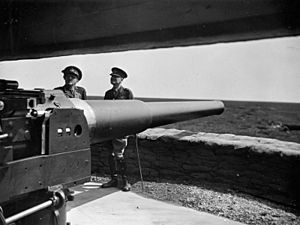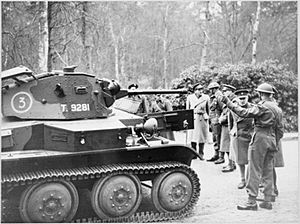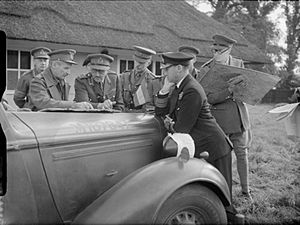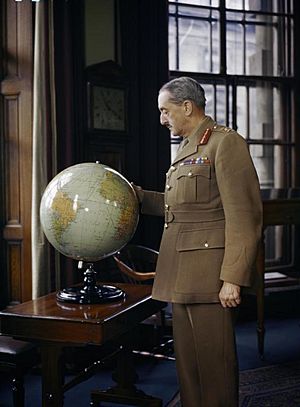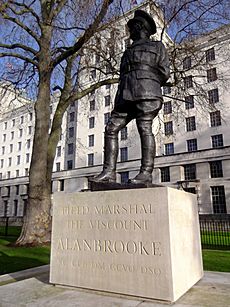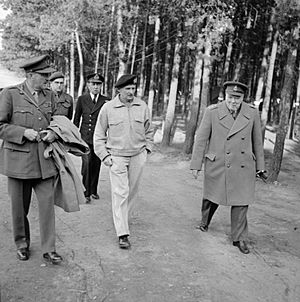Alan Brooke, 1st Viscount Alanbrooke facts for kids
Quick facts for kids
The Viscount Alanbrooke
|
|
|---|---|
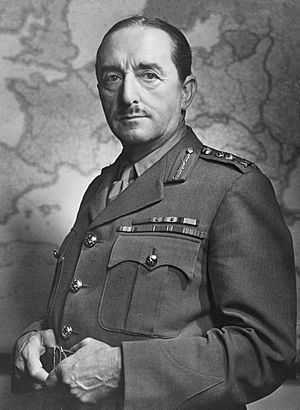
Brooke in 1943
|
|
| 3rd Chancellor of the Queen's University Belfast | |
| In office 1949–1963 |
|
| Monarch | George VI Elizabeth II |
| Preceded by | 7th Marquess of Londonderry |
| Succeeded by | Sir Tyrone Guthrie |
| Personal details | |
| Born |
Alan Francis Brooke
23 July 1883 Bagnères-de-Bigorre, France |
| Died | 17 June 1963 (aged 79) Hartley Wintney, Hampshire, England |
| Nicknames | "Brookie" "Colonel Shrapnel" |
| Military service | |
| Allegiance | United Kingdom |
| Branch/service | British Army |
| Years of service | 1902–1946 |
| Rank | Field Marshal |
| Unit | Royal Artillery |
| Commands | Chief of the Imperial General Staff (1941–1946) Home Forces (1940–1941) II Corps (1939–1940) Southern Command (1939) Mobile Division (1937) 8th Infantry Brigade (1934–1935) School of Artillery (1929–1932) |
| Battles/wars | First World War Second World War |
| Awards | Knight of the Order of the Garter Knight Grand Cross of the Order of the Bath Member of the Order of Merit Knight Grand Cross of the Royal Victorian Order Distinguished Service Order & Bar Mentioned in Despatches (7) See below |
Field Marshal Alan Francis Brooke, 1st Viscount Alanbrooke (born July 23, 1883 – died June 17, 1963) was a very important officer in the British Army. He was the top military advisor to Prime Minister Winston Churchill during World War II.
Brooke was the professional head of the British Army, known as the Chief of the Imperial General Staff (CIGS), from 1941 to 1946. He also led the Chiefs of Staff Committee, which helped plan Britain's war efforts. His leadership was key to the Allies winning the war in 1945. After the war, he helped with the Coronation of Queen Elizabeth II in 1953.
Contents
Who Was Alan Brooke?
Early Life and Education
Alan Brooke was born in France on July 23, 1883. His family was from Ulster, a region in Ireland, and had a long history of serving in the military. His father passed away when Alan was only eight years old.
He grew up speaking both French and English very well. He also learned German, Urdu, and Persian. Brooke wanted to join the army. He got into the Royal Military Academy at Woolwich in 1900. He joined the Royal Regiment of Artillery in 1902. Before World War I, he served in Ireland and India.
Alan Brooke in World War I
Planning and Tactics
During World War I, Brooke served on the Western Front. He became known as a great planner of military operations. At the Battle of the Somme in 1916, he used a new tactic called the "creeping barrage." This helped protect soldiers as they advanced by having artillery fire move forward just ahead of them.
He also planned the artillery attacks for the Battle of Vimy Ridge in 1917. By the end of the war, he was a lieutenant-colonel. He received several awards for his bravery and skill.
Reflections on War
The war had a big impact on Brooke. In 1918, he wrote about the destruction he saw in Lens, France. He wondered if there would ever be another war if stones could tell the stories of dying men.
When the war ended, he felt a mix of relief and sadness. He remembered all the struggles of the war years.
Between the World Wars
Building a Career
After World War I, Brooke continued his military training. He impressed his teachers and fellow officers. He became an instructor at the Imperial Defence College. There, he met many officers who would become important leaders in World War II.
From 1929, he held several key positions. He became the Inspector of Artillery and Director of Military Training. In 1935, he led the Mobile Division, which later became the 1st Armoured Division. In 1938, he took command of the Anti-Aircraft Corps. He worked closely with Hugh Dowding, who led Fighter Command. This teamwork was very important during the Battle of Britain later on. By the start of World War II, Brooke was seen as one of Britain's best generals.
Alan Brooke in World War II
Commander in France and Britain
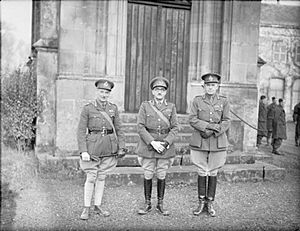
When World War II began in September 1939, Brooke commanded II Corps in the British Expeditionary Force (BEF) in France. He worried that the French and Belgian armies might not be strong enough against a German attack. He also didn't trust Lord Gort, the BEF's commander.
Brooke correctly predicted that the German army would try to go around the Allied forces. When the Germans attacked, Brooke showed great skill in leading his troops during the retreat to Dunkirk. His forces held off a major German attack, which helped save many British soldiers.
He was ordered back to England, leaving his corps to Bernard Montgomery. Brooke was then told to return to France to form a new BEF. However, he realized that it was hopeless to keep British forces in France. He convinced Prime Minister Churchill to withdraw all British troops. Thanks to his efforts, about 200,000 British and Allied soldiers were safely evacuated from France.
Defending Britain
In July 1940, Brooke was put in charge of Home Forces in the United Kingdom. His job was to prepare Britain for a possible German invasion. Unlike his predecessor, Brooke believed in having a mobile reserve. This reserve would quickly counterattack German forces if they landed. He also planned for a light defense line along the coast to slow down any landings.
Brooke was confident that Britain could defend itself, even though he felt there weren't enough troops. He even considered using mustard gas on the beaches if the Germans invaded. Luckily, the German invasion plan, called Operation Sea Lion, never happened.
Chief of the Imperial General Staff (CIGS)
In December 1941, Brooke became the Chief of the Imperial General Staff (CIGS). This made him the professional head of the British Army. He also became the chairman of the Chiefs of Staff Committee, which guided Britain's overall war strategy.
As CIGS, Brooke was the main military advisor to Prime Minister Churchill. He was responsible for leading the entire British Army. He focused on big-picture strategy, choosing top commanders, and managing resources. He also worked closely with American military leaders in the Combined Chiefs of Staff.
Brooke believed that focusing on the Mediterranean area was important. He wanted to defeat Axis forces in North Africa and get Italy out of the war. This would open up the Mediterranean Sea for Allied ships. He then wanted to launch a cross-Channel invasion of Europe when the Allies were ready.
His views often clashed with American leaders, who wanted an earlier invasion of Western Europe. At the Casablanca Conference in 1943, it was decided to invade Sicily, which delayed the invasion of Western Europe until 1944.

Brooke was responsible for choosing top generals. When a new commander was needed for the British Eighth Army in 1942, Brooke chose Bernard Montgomery over Churchill's choice. Montgomery later became a very successful commander.
Brooke was disappointed when he was not chosen to lead the Allied invasion of Western Europe. He felt he had been promised the role. However, the job went to Dwight D. Eisenhower instead.
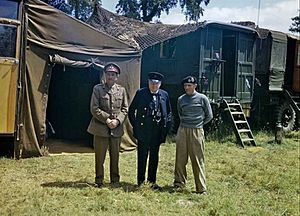
Brooke was known for his quick thinking and direct style. He was highly respected by other military leaders. His opposition to an early landing in France was crucial. It helped delay Operation Overlord until June 1944, when the Allies were better prepared.
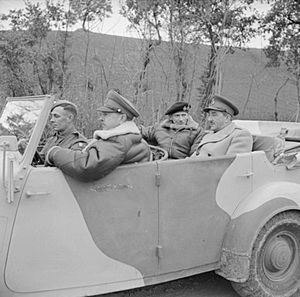
Working with Winston Churchill
Brooke had a challenging relationship with Prime Minister Winston Churchill. Brooke often got frustrated with Churchill's habits and his constant involvement in military plans. However, he also greatly admired Churchill's ability to inspire the country and lead during the war.
Brooke wrote in his diary that Churchill was a "genius mixed with an astonishing lack of vision." He called him "the most difficult man to work with." But he also said he wouldn't have missed the chance to work with him for anything.

Churchill once said about Brooke, "When I thump the table and push my face towards him what does he do? Thumps the table harder and glares back at me." This shows how strong-willed Brooke was. Many believe that Churchill's decision to keep Brooke as CIGS for the entire war was a sign of Churchill's own greatness.
Brooke often had to stand up to Churchill's more imaginative, but sometimes impractical, ideas. For example, he disagreed with Churchill's idea of capturing the northern tip of Sumatra.
Despite their many arguments, Brooke and Churchill had a deep respect for each other. Once, Churchill thought Brooke hated him. Brooke replied, "I don't hate him. I love him. But the first time I tell him that I agree with him when I don't will be the time to get rid of me." When Churchill heard this, he said, "Dear Brookie."
Their partnership was very successful and helped Britain win the war in 1945.
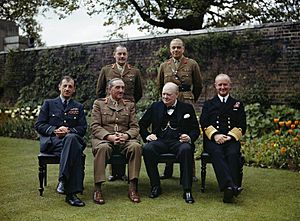
Brooke's War Diaries

Alan Brooke kept a diary throughout World War II. He originally wrote it for his wife, Benita. The diaries describe the daily events of the British war effort. They also share Brooke's thoughts on strategy and his meetings with Allied leaders.
The diaries are famous for their honest comments and criticisms of Churchill. While they show admiration for Churchill, they also reveal Brooke's frustrations. The diaries also give strong opinions on other top Allied leaders. For example, he described American generals Eisenhower and Marshall as poor strategists.
Brooke admired Joseph Stalin for his quick mind and understanding of military strategy. However, he had no illusions about Stalin as a person. He described Stalin's face as "unpleasantly cold, crafty, dead."
Brooke later expanded his diaries in the 1950s. He decided to publish them partly because he felt Churchill's own war memoirs didn't give enough credit to him and the Chiefs of Staff. The first published versions were edited and censored. Later, in 2001, a full, unedited version of the diaries was published.
After the War
New Roles
After World War II, Lord Alanbrooke retired from the army. He chose to become the Colonel Commandant of the Honourable Artillery Company. He also joined the boards of several companies, including the Anglo-Iranian Oil Company and the Midland Bank. He especially enjoyed being a director of the Hudson's Bay Company.
He also served as Chancellor of The Queen's University of Belfast from 1949 until his death. In 1953, during the Coronation of Queen Elizabeth II, he was appointed Lord High Constable of England. This meant he commanded all the troops taking part in the event.
Private Life and Hobbies
Alan Brooke loved nature. He enjoyed hunting and fishing. His greatest passion was birds. He was a well-known ornithologist, especially for his bird photography. In 1944, he even stopped the Royal Air Force from using an island as a bombing range because it was important for nesting roseate terns.
He was president of the Zoological Society of London from 1950 to 1954. He was also vice-president of the Royal Society for the Protection of Birds from 1949 to 1961.
Brooke was married twice. His first wife, Jane, died in 1925 from complications after a car accident. Brooke blamed himself for the accident and felt guilty for the rest of his life. He later married Benita Lees in 1929. This marriage was very happy.
Death and Legacy
Alan Brooke passed away on June 17, 1963, from a heart attack. He was buried in St Mary's Church, Hartley Wintney.
In 1993, a statue of Field Marshal Lord Alanbrooke was put up in front of the Ministry of Defence in London. It stands next to statues of two other important British generals from World War II, Viscount Slim and Viscount Montgomery.
Honours and Awards
United Kingdom Awards
Brooke received many honours for his service. He was made Baron Alanbrooke in 1945 and Viscount Alanbrooke in 1946. Some of his other awards include:
- Knight of the Garter (KG) in 1946
- Knight Grand Cross of the Order of the Bath (GCB) in 1942
- Member of the Order of Merit (OM) in 1946
- Knight Grand Cross of the Royal Victorian Order (GCVO) in 1953
- Distinguished Service Order (DSO) in 1916 and a Bar in 1918
Foreign Awards
He also received awards from other countries, such as:
- Order of Polonia Restituta 1st Class (Poland) (1943)
- Order of Suvorov 1st Class (USSR) (1944)
- Grand Cordon of the Order of Leopold with Palm (Belgium) (1946)
- Military Order of the White Lion (Czechoslovakia) (1946)
Memorials
Several places are named after Alan Brooke:
- Welbeck College and the Duke of York's Royal Military School have houses named after him.
- Military barracks in Germany and Topcliffe, North Yorkshire, are called Alanbrooke Barracks.
See Also
 In Spanish: Alan Brooke para niños
In Spanish: Alan Brooke para niños



